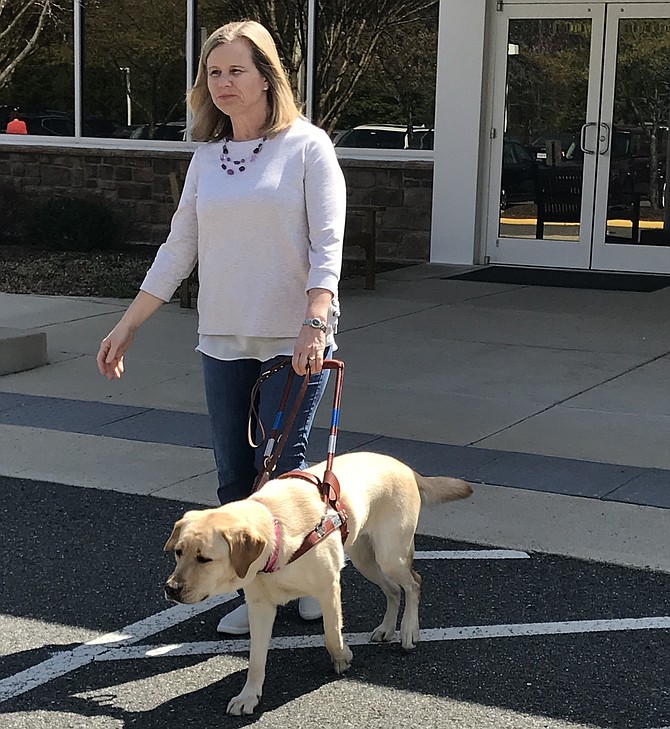Guide dog Betty safely leads Carol Edwards of Herndon across the street. Photo by Mercia Hobson.
Carol Edwards of Herndon knew one day she would get a guide dog. The working wife, and mother of two college-aged young adults, slowly lost her vision over time and stopped doing the things she liked to do.
"It wasn't one specific incident, but several. Going out with friends at night, walking and traveling independently." Diagnosed in childhood with Retinitis Pigmentosa (RP), Edwards no longer had any night vision, and most of her peripheral vision was gone from the inherited progressive disease.
In late March, Team Edwards and guide dog, Betty, a female yellow Labrador Retriever, graduated from the Residential Program of Guiding Eyes for the Blind in Yorktown Heights, N. Y.
"Betty knows what to do," said Edwards. "It is a testament to Guiding Eyes for the Blind, the perfect school for me," she said. Guiding Eyes "checked off" all of the boxes. Edwards said she wanted a small class size, training in urban and suburban environments and offer of a Labrador retriever.
According to Guiding Eyes for the Blind, the nonprofit organization is an international leader in breeding and genetics. It charges nothing for their dogs, training and a lifetime of follow-up services.
"Our pups grow up to become exceptional guide dogs and service dogs because they begin with a solid foundation of good genes. … We estimate the cost to breed, raise, train, and match a Guiding Eyes dog with a person with vision loss to be approximately $50,000," stated Guiding Eyes on its website.
EDWARDS explained the eligibility and admissions process to Guiding Eyes. Applicants must be legally, or totally blind and provide "written paperwork from an eye doctor letting them know vision levels," said Edwards. According to Edwards, the applicant had to be able to take care of the guide dog from feeding to walking.
Ben Crawley, Director of Admissions and Graduate Relations, Guiding Eyes for the Blind said, “The road to getting a guide dog requires hard work and dedication. Future guide dog users must first learn how to travel with a white cane, trained by an Orientation and Mobility Instructor. Learning to travel, stay oriented, cross streets and problem solve independently are all skills that need to be mastered before training with a guide dog."
Edwards described the 3-week residential program at the Guiding Eyes for the Blind campus held at the organization's training center in Yorktown Heights, N.Y. There she and others learned how to care for and safely travel with their new guide dogs. The training started on- campus and progressed to nearby towns and cities.
"The first couple of days, I worked with the trainers. They are walking with you, teaching you the commands. They record your walking pace, and they match the dogs to your speed," Edwards said. "The second day, they had me walk with two different dogs. After I walked with both dogs, the trainer asked how did that feel, too slow, too fast? On the third day, I got my dog, Betty. We worked on obedience training. I was the one being trained; the dog had been working with the trainer for a long time and knew what to do," she said.
Edwards said that contrary to popular belief, guide dogs cannot see a green stoplight nor can they read and understand traffic signals. "It's my responsibility to learn when to cross. If I ask the dog to cross the street and the dog sees a car, the dog will choose not to listen to my command, ‘Forward.’ This is intelligent disobedience. If I ignore the dog's signs, I may step off the curb or cross. I must stay in tune with the dog at all times."
Since Betty is responsible for keeping Edwards safe, others may not pet Betty when she is in harness, working. "Her harness is like a switch. When she is in the harness, she is working. Not in harness, she can be a family pet," said Edwards.
Cawley added: "One of the biggest obstacles to public access guide dog users face is a distraction by other dogs. It is important that guide dog teams are allowed to work without being distracted.
PETTING, speaking to or allowing pet dogs to approach guide dogs can be very challenging distractions for a guide dog team. In some cases, distraction can cause the guide dog to lose focus on its work. An unfocused dog can make errors and be potentially dangerous to the team."
To maintain the strong bond between Edwards and Betty, Edwards is the only person who is allowed to feed and walk Betty. Having a guide dog is work. "I have a lot of visually impaired friends, and out of all of them, I'm the only one with a dog. When you have a cane, you can fold it up and put in your purse. When you have a guide dog, it's work,” said Edwards.
Edwards said she chose a guide dog over a cane because a dog allowed her to walk at a quicker, more natural pace and took over some of the mental workloads such as counting streets, remembering whether to turn left or right. "Because I don't drive, I walk to work. Betty knows my route. She's memorized it. With a cane, I'd have to think, through the route. Right, left, left, etcetera. It's more mental work with a cane," Edwards said.
About Guiding Eyes for the Blind
Guiding Eyes for the Blind is dedicated to creating and supporting life-changing connections between people and dogs. As 501(c)(3) nonprofit organization, it breeds and trains dogs for people who are blind or visually impaired. The dogs are known for their exceptional temperaments and success at helping people gain independence and to expand their horizons of opportunity.
